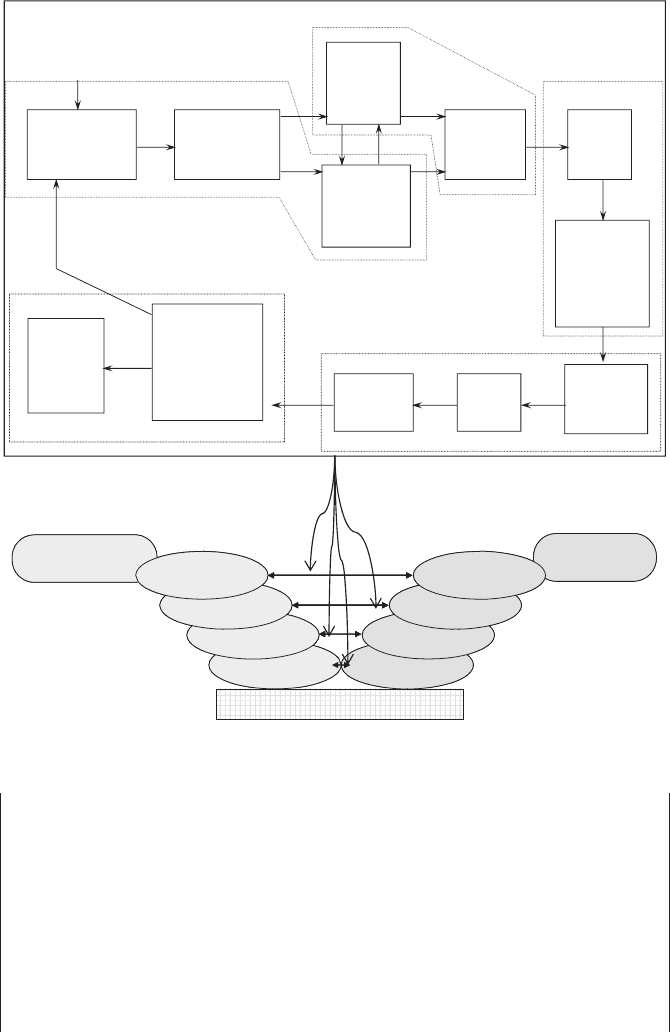Buede D.M. The Engineering Design of Systems Models and Methods
Подождите немного. Документ загружается.


TABLE 11.3 Qualification Methods
Method Description Used during: Most effective when:
Inspection
(Static Test)
Compare system
attributes to
requirements.
During all segments of
verification,
validation and
acceptance testing
for requirements
that can be
addressed by human
examination.
Success or failure can
be judged by
humans; examples
include inspection
of physical
attributes, code
walk-throughs and
evaluation of user’s
manuals.
Analysis and
Simulation
Use models that
represent some
aspect of the
system.
Examples of models
might address
system’s
environment,
system process,
system failures.
Used throughout
qualification, but
emphasis is early in
verification and
during acceptance.
Physical elements are
not yet available.
Expense prohibits
instrumented test,
and demonstration
is not sufficient.
Often used in
conjunction with
demonstration.
Issue involves all or
most of the system’s
life span.
Issue cannot be tested
(e.g., survive
nuclear blast).
Instrumented
Test
Use calibrated
instruments to
measure system’s
outputs. Examples
of calibrated
instruments are
oscilloscope,
voltmeter, LAN
analyzer.
Verification testing. Engineering test
models through
system elements are
available.
Detailed information
is required to
understand and
trace failures.
Life and reliability
data is needed for
analysis and
simulation.
Demonstration
or Field Test
Exercise system in
front of unbiased
reviewers in
expected system
environment.
Primarily used for
validation and
acceptance testing.
Complete
instrumented test is
too expensive.
High level data/
information is
needed to
corroborate results
from analysis and
simulation or
instrumented test.
11.7 QUALIFICATION METHODS 361

with top-down, bottom-up, and big-bang integration. Functional testing
examines the system at the level of inputs and outputs under mostly nominal
conditions. Structural testing deals with specific characteristics of the outputs
as well as the system-wide properties such as safety, availability, and recovery.
Structural testing pays particular attention to the most extreme environments
that the system will experience.
Samson [1993] postulates four facets for any qualification activity: structural
(relation to system implementation), function (relation to system functions),
environment (relation to environmental conditions), and conditions (relation to
requirement characteristic). The first two of these facets are mutually exclusive
and are described in Table 11.4. The second two need to be added to each
specific structural or functional test to make it complete. In other words there
has to be an environmental facet and a conditional facet for each functional test
and each structural test. Table 11.5 shows Samson’s examples of these facets.
Black box and white box testing methods (Table 11.6) are commonly
employed in software testing. For each method test cases must be specified and
test data generated as inputs. These inputs are then injected into both the system
prototype (which is essentially a model of the eventual system) and a model of the
system. The outputs of the system and the model are compared; any discrepancies
are checked to determine whether the system or the model is incorrect [see
Chusho, 1987; Richardson and Clarke, 1985; Voges and Taylor, 1985].
11.8 ACCEPTANCE TESTING
Acceptance testing is the fina l step in qualification and is separated from
validation because acceptance testing is conducted by the stakeholders, whereas
TABLE 11.4 Testing Methods
Functional
testing
Test conditions are set up to ensure that the correct outputs are
produced, based upon the inputs of the test conditions. Focus is on
whether the outputs are correct given the inputs (also called black
box testing).
Structural
testing
Examines the structure of the system and its proper functioning.
Includes such elements as performance, recovery, stress, security,
safety, availability. Some of the key elements are described below.
Performance Examination of the system performance under a range of nominal
conditions, ensures system is operational as well.
Recovery Various failure modes are created and the system’s ability to return to
an operational mode is determined.
Interface Examination of all interface conditions associated with the system’s
reception of inputs and sending of outputs.
Stress
testing
Above-normal loads are placed on the system to ensure that the
system can handle them; these above-normal loads are increased to
determine the system’s breaking point; these tests may proceed for a
long period of time in an environment as close to real as possible.
362
INTEGRATION AND QUALIFICATION

verification and validation have been conducted by the development team of
systems engineer s. In order for the development process to proceed efficiently
and effectively, the thresholds for acceptance need to be defined early in
the requirements development process by the stakeholders with the help of
the systems engineering team. In fact, in Chapter 6 the agreement on the
TABLE 11.5 Examples of Testing Facets
Structural Facet Functional Facet Environmental Facet Conditional Facet
Compliance Algorithm analysis Computer-supported Accuracy
Execution Control Live Adequacy
External Error handling Manual Boundary
Inspection Intersystem Prototype Compliance
Operations Parallel Simulator Existence
Path Regression Testbed Load
Recovery Requirements Location
Security Logic
Quality
Sequence
Size
Timing
Typing
Utilization
TABLE 11.6 Black and White Box Testing
Black box
testing
Outputs are determined correct or incorrect based upon inputs; inner
workings of the module are ignored. Both positive and negative
testing have to be employed. This approach is scalable to system-
level testing
Positive testing pulls the test data and sequences from the
requirements documents.
Negative testing attempts to find input sequences missed in the
requirements documents and then determine how the module reacts.
Crash testing is an example.
White box
testing
Inner workings of the module are examined as part of the testing to
ensure proper functioning. Usually used at the CI level of testing;
this method becomes impractical at the system level
Path testing addresses each possible simple functionality and is based
upon a prescribed set of inputs.
Path domain testing partitions the input space and then examines the
outputs for each partition of the input space.
Mutation analysis injects pre-defined errors and tests the error
detection and recovery functionalities.
11.8 ACCEPTANCE TESTING 363
acceptance criteria was defined to be the exit criterion for the requirements
development.
The acceptance test determines whether the stakeholders, especially the bill
payer, is willing to accept the system as it is; accept it subject to certa in
changes; not accept it; or accept it after certain changes have been made.
Acceptance testing focuses on the use of the system by true users, typically a
small, but representative sample of users. (During verification and validation,
members of the systems engineering team and discipline engineers conducted
the use of the system.) As a result, usability characteristics of the system are a
major focus. Another characteristic of acceptance testing is the lack of time
and money to conduct thorough, controlled tests of the system with users
from which inferences, based on class ical statistics, can be drawn. The two big
issues in acceptance testing are what to test and how to test the usability of
the system.
11.8.1 Deciding What to Test
Common wisdom says that everything possible, including all functionalities or
paths, should be tested. The case study about the Ariane 5 failure is one of
many examples that support this wisdom. In fact, during verification and
validation the key question is not ‘‘what should be tested?’’ but ‘‘what have we
forgotten to test?’’ The more systematic the design process the more likely it is
that key issues for testing will arise. Nonetheless, it is imperative that everyone
involved in the design and integration process constantly question where
problems might arise. If only someone on the Ariane 5 development team
had insisted on running the new flight envelope through the software of the
inertial reference system, the design flaw would have surfaced. This is an area in
which the brainstorming techniques discussed in Chapter 9 can be useful to
generate potential test issues, not all of which will be meaningful, but some of
which may save the system from the disasters of Ariane 5 and Hubble.
The question of ‘‘what should be tested?’’ becomes very relevant during
acceptance testing. Acceptance testing substitutes developmental testers with
real users but must rely on all of the previous testing activities. Exhaustive
repetition of verification and validation is not feasible during acceptance testing
due to the limits of time and money. The focus of acceptance testing is whether
the system is acceptable or not as is; and if not, why. But what does it mean to
say that the system is acceptable? Can we distinguish only between acceptable
and unacceptable? Acceptability is defined here to mean the stakeholders want
to deploy the system as it is as soon as practically possible, with whatever flaws
there are. More flaws are acceptable to stakeholders when the current system’s
deficiencies are causing severe problems for the users in accomplishing their
goals, for the buyers in maintaining market share, or with the victims in
suffering too many losses. However, the stakeholders may be willing to accept
the system, yet still demand major changes quickly. The system is unacceptable
when it will cause more problems than the current system. Similarly, the system
364 INTEGRATION AND QUALIFICATION
can be totally unacceptable beyond the possibility of improvement or unac-
ceptable until certain changes are made.
The acceptance test can either be designed under the assumption that the
system is acceptable or that it is not. If the assumption that the system is
acceptable is chosen, the test should be designed to prove it is not. A test
designed to try to prove that the system is not acceptable would probably
include a relatively small set of challenging activities that are key to the system’s
performance. If the system cannot perform so me of these challenging activities,
then it can be failed. On the other hand, if the test design assumption is that the
system is not acceptable, then a reasonabl e amount of standard activity would
be included in the test in order for the test to prove that the system is
acceptable. If the system can pass most of these standard activities, then it
can be accepted. Recall that a statement cannot be proven true by example, but
it can be proven false by example. This latter approach is the more common in
acceptance tests but not the more defensible.
Decision analysis (see Chapter 13) provides a rational, defensible way to
analyze alternate acceptance test designs, including a seldom used option of no
acceptance test or accept the system after verification and validation. The
decision is whether to accept or not accept the system; the other options of
accept but fix and do not accept until fixed should also be included . Now test
designs are ways to gather infor mation about system parameters about which
uncertainty exists. This increased information, when collected during the test,
may update this uncertainty in ways that are sufficient to justify accepting or
not accepting the system.
11.8.2 Usability
In Chapter 6 usability testing with prototypes was discussed as a method of
generating requirements. In qualification, usability testing is again used as part
of acceptance testing to determine the success with which the requirements have
been met.
In fact, usability testing is also used as part of verification testing when an
iterative or evolutionary design process is employed. Limited experimental
results for eva luating the effectiveness of evolutionary design are reported by
Nielsen [1993, p. 107]. The median improvement over four projects was 38%
per iteration, but with a high degree of variability. As a result at least three
iterations are recommended.
Recall from Chapter 6 that usability concerns five aspects of a user’s
interaction with a system: learnability, efficiency or ease of use, memor ability,
error rate, and satisfaction. These characteristics should be part of the system-
wide requirements for most systems. These characteristics can typically not be
tested adequately until the entire system has been assembled or simulated.
During validati on, the characteristics are tested by specia lly defined sets of
users. Larger samples of users, often uncontrolled sets of users called beta
testers, address these five aspects during acceptance testing.
11.8 ACCEPTANCE TESTING 365
When designing any test queries, there are two central issues: Is the query
reliable and is the query valid? Reliable queries are queries that will result in the
same response when repeated. Reliability is a major problem that cannot be
solved completely due to the large individual differences among users. Segment-
ing the users into relatively homogeneous groups along the dimensions of domain
experience, computer experience, and experience with the system under develop-
ment helps significantly to obtain a reasonable chance of repeatability. To obtain
sample users in this last of the three dimensions, there must be a sustained effort
to train selected users to become very experienced users. Care must be used in
defining homogeneous segments of users. If each of the three dimensions is
categorized at two extremes, there are 8 (2
3
) different combinations. Not all of
these combinations may be that interesting for the system in question. There may
be some interest in user groups that are midrange in one or more of these
dimensions; for most systems the predominant number of users will be neither
naive nor expert along any of these three dimensions. However, there are some
systems for which all users will be trained extensively before even being allowed
access to the system, for example, air traffic control systems, and aircraft.
However, for these systems the memorability factor of usability may be critical.
Valid que ries are those that are measuring the right or appropriate aspect of
the system. For usability this will refer back to the five concerns outlined above.
See the metrics in Table 6.5.
The best way to achieve reliability and validity of test measures is to set up
relevant tasks on which tests will be conducted and measures taken. These
tasks should be drawn from the operational concep t; each task may be a
complete scenario or a small segment of a scenario, depending on where in the
qualification process the test is being used. Complete scenarios should be used
during accep tance and the latter stages of validation. Segments can be used
during prototyping and the early stages of validation. Each task must define a
realistic setting for the user in terms of the system and its context, a specified set
of circumstances in which to be performing the task, a well-defi ned outcome
that the user is expected to achieve, and a realistic time interval in which to
complete the task.
Cox et al. [1994] state the most serious obstacles to successful usability tests are:
Obtaining test participants that represent the real users of the system
Securing a representative sample that will be predictive of how the total
population will evaluate the system
Selecting the tasks that are most critical to the usability needs of real users
Writing test scenarios that accurately represent real task situations that a
user will encounter in the system’s environment
Predicting which of the user interface characteristics are most critical or
most often used
Yet these obstacles must be overcome for usability testing to be successful.
366 INTEGRATION AND QUALIFICATION
11.9 SUMMARY
Integration begins when assemblies of CIs and components are evaluated in
terms of the derive d requirements. This process is part of verification,
determining that the system was built right. There are several approaches to
integration, bottom-up being the most common one to systems engineering.
Top-down and big-bang integration are more co mmon in software engineering.
Verification and integration end at the system level.
Qualification consists of verifica tion, validation, and acceptance testing.
Verification addresses the comparison of the specifications for the system’s CIs,
components, subsystems, and the system to the actual designs to make sure the
designs are right, that is, meet the specifications.
Validation consists of early validation and operational validation. Early
validation (conceptual, requirements, and design validity) proceeds during
design to ensure that the design process is valid. Conceptual validity add resses
the congruen ce between the stakeholders’ needs and the operational concept.
This is the hardest element of validation to complete successfully. Require-
ments valid ity applies to the conformity between the operational concept and
the stakeholders’ requirements. Design validity addresses the coherence be-
tween the stakeholders’ requirements and the layers of derived requirements
associated with the system, components, and CIs.
Operational validity may begin before verification is complete, but ends
after verification is complete and addresses the conformance of the system
as it has been built with the operational concept. This is the last phase of
the development process under the comp lete control of the systems engineering
team.
Acceptance testing is controlled by the stakeholders and provides the
stakeholders the final opportunity to review the design and verify that it meets
their needs. Acceptance testing should fully utilize all of the data and analyses
that have been part of verification and validation. At the same time, though,
acceptance testing is focused on the use of the system by representatives of the
stakeholders’ community, whereas verification and validation employ highly
qualified users (i.e., engineers) as stakeholders for the most part. As a result the
system’s usability is a major focus during acceptance testing.
There are two critical chains whose links are checked during qualification.
The top-level chain consists of these links: conceptual validity, operational
validity, and acceptability. The first link is validated early in the design
phase; the last two links are addressed at the end of integration. The second
chain consists of requirements validity, design validity, verification, and
operational validity. Note that operational validity is common to both chains,
and recall that the chain is as strong as its weakest length. Therefore, it is a
mistake to assert that any one of the links is more important than any of the
others.
11.9 SUMMARY 367

CASE STUDY: THERAC-25
The Therac-25 was a computer-controlled machine that pro vided radia-
tion therapy in the late 1980s. Three patients were killed and one seriously
injured by radiation overdoses in the 1985–198 7 time frame when four
different operators entered an acceptable, but infrequently used, sequence
of commands. While this tragedy can be traced to requirements and
design errors, the qualification process should be focused on catching just
this sort of flaw. This was clearly a case in which all possible data entry
sequences should have been tested [Jacky, 1990].
The development of the qualification system should be approached just
as the development of any system, as described in Chapters 6 to 10. The
operational concept, external systems diagram, objectives hierarchy, require-
ments, and architectures (functional, physical, and allocated) are all critical
elements of the development of the qualification system. Besides addressing
verification, validation, and acceptance, the qualification system is often
broken into four methods (or components): inspection, analysis and simula-
tion, instrumented test, and demonstration.
While it is common to visualize the qualific ation system as the system that
will detect and isolate faults in the product system’s design, design of the
qualification system, when done right, also reinforces the design process and
reduces the introduction of faults into the design of the system.
In summary for Section 2 of this book, the Traditional, Top-Down Systems
Engineering (TTDSE) process has been descri bed in some detail. Figure 11.8
integrates Figures 1.6 and 1.19 to bring the major elements of Chapters 6
through 11 together into a single picture. The point of this figure is that the
process described in Chapters 6 through 11 is repeatedly applied to the process
of ‘‘peeling the onion’’ of the layers of the system. Each preceding layer
provides the starting information for the layer before it. The major difficulty is
getting started when very little needed information is available.
CASE STUDY: FAILURE OF THE ARIANE 5
Ariane 5, a launch vehicle developed by the European Space Agency
(ESA), was first launched on June 4, 1996, with four satellites that would
become the backbone of the Solar Terrestrial Science Programme. These
four satellites wer e developed by 500 scientists in over 10 years for about
$500 million. But at 37 seconds into the flight Ariane 5 veered off course
and disintegrated shortly after. The failure was traced to the two inertial
368 INTEGRATION AND QUALIFICATION

reference systems (SRIs), one of which was in ‘‘hot’’ standby mode for the
other. Both SRIs failed when their software converted a 64-bit floating-
point number to a 16-bit signed integer value. The conversion failed when
the floating-point number was too large for the 16-bit signed integer,
resulting in an operand error for which there was no protection. The
system operated as designed when this failure occurred: the failure was
indicated on the data bus, the failure context was stored in EEPROM
memory, and the SRI processor was shut down.
During the design of the SRI there was a strong theme of designing to
prevent random errors. In addition, a requirement had been set to limit
Higher Level
Requirements &
Constraints from
Approved Baseline
Define the
problem, the
system/segment/CI
Boundary, & the
objectives
Develop the
Op’l Concept
for the Sys,Seg,CI
under analysis
Define the
required
behavior in
a functional
interaction
diagram
Define the
required
functional
performance
by quantitative
analysis
Allocate
requirements
to functions
Define
candidate
physical
solutions
Evaluate
candidate
physical
solutions
& select
best based
upon objectives
& requirements
Allocate
functions
to Seg/CIs,
derive
requirements
Develop
interfaces
between
Seg/CIs
Plan test
& integration
of Seg/CIs
Obtain
approval
of boundary,
objectives,
concept of ops,
requirements,
physical solution,
& test plan
Document
Seg/CI
design
as approved
baseline
for next
lowest level
yes
no
Define the Design Problem
(Chapter 6)
Develop Functional Architecture
(Chapter 7)
Develop
Physical
Architecture
(Chapter 8)
Develop Allocated Architecture
Obtain Approval & Document
(Chapter 9)(Chapter 10)(Chapter 11)
System analysis;
Upgrade selection
Meta-system analysis;
Concept selection
Discipline Engineering Design
CI Definition
Component Definition
Subsystem Definition
System Definition
CI Verification
Component Verification
Subsystem Verification
System V,V &A
V
,
V
&
A
S
y
s
t
e
m
D
e
s
i
g
n
R
e
q
u
i
r
em
e
n
t
s
De
r
i
v
a
t
i
o
n
A
r
c
h
i
t
e
c
t
u
r
e
D
e
f
i
n
i
t
i
o
n
V
,
V
&
A
T
e
s
t
i
n
g
R
e
q
u
i
r
e
m
e
n
t
s
A
d
j
u
s
t
m
e
n
t
A
r
c
h
i
t
e
c
t
u
r
e
M
od
i
f
i
c
a
t
i
o
n
System analysis;
Upgrade selection
Meta-system analysis;
Concept selection
Discipline Engineering Design
CI Definition
Component Definition
Subsystem Definition
System Definition
CI Verification
Component Verification
Subsystem Verification
System V,V &A
V
,
V
&
A
S
y
s
t
e
m
D
e
s
i
g
n
R
e
q
u
i
r
em
e
n
t
s
De
r
i
v
a
t
i
o
n
A
r
c
h
i
t
e
c
t
u
r
e
D
e
f
i
n
i
t
i
o
n
V
,
V
&
A
T
e
s
t
i
n
g
R
e
q
u
i
r
e
m
e
n
t
s
A
d
j
u
s
t
m
e
n
t
A
r
c
h
i
t
e
c
t
u
r
e
M
od
i
f
i
c
a
t
i
o
n
FIGURE 11.8 Repeated application of TTDSE to the layers of the system’s design.
11.9 SUMMARY 369

the maximum workload of the SRI computer to 80% of its capacity. An
analysis was done during the developmen t and testing of the SRI
software to determine the vulnerability of the code due to exceptions
such as operand errors. Analysis of conversions from floating-point to
integer numbers yielded seven variables that could cause an operand
error. A deliberate decision was made to protect four of the variables.
The other three, including the one that caused the SRI failure, were
judged to be protected by either physical limitations or a large margin of
safety. A clear trade-off decision was made in this design to risk an
operand error in lieu of increasing the workload on the SRI computer.
The testing and qualification procedures set out for the flight control
system of Ariane 5 consisted of four levels: equipment qualification,
software qualification, stage integration, and system validation. No test
was done on the SRI to examine the operational scenario associated with
the countdown an d flight trajectory of the Ariane 5. This scenario could
not be tested with the SRI as a black box. However, the SRI could have
been test ed by feeding simulated acceleration signals into the SRI while
the SRI was placed on a turntable to provide realistic movement. This
test was not done because the SRI specification does not requ ire the SRI
to be operational after launch. The purpose of the SRI was to provide
inertial reference data prior to launch. Even though the SRI served no
useful purpose after launch, its operation after launch was sufficient to
cause the destruction of Ariane 5 37 seconds into the flight.
Much of the Ariane 5 requirements and software were inherited from
earlier versions of Ariane. Ten years earlier requirement s had been
established that the SRI operate 50 seconds beyond the initiation of
flight mode. Flight mode started at — 9 seconds for Ariane-4; this allowed
restarting the countdown without waiting for a normal alignment of the
spacecraft, which takes about 45 minutes. However, Ariane 5 had a
different initiation sequence that did not require the SRI being active
during flight. This is one case in which the old adage ‘‘if it ain’t broke, don’t
fix it’’ caused a failure.
The final stage at which this error could have been detected was at the
Functional Simulation Facility (ISF) which tests (1) guidance, naviga-
tion, and control performance in the whole flight envelope, (2) sensor
redundancy operation, and (3) flight software compliance with all
equipment of the flight control electrical system. ‘‘Technically valid
arguments’’ [Lions. 1996] were presented for not having the SRIs in the
loop for the tests conducted at the ISF. As a result the SRIs were never
tested for the Ariane 5 launch. The trajectory profile of Ariane 5 was
sufficiently different than the profiles of previous Ariane launches that
this operand error would always occur; a major requirements’ failure
followed by a failure of test design [Lions, 1996].
370 INTEGRATION AND QUALIFICATION
